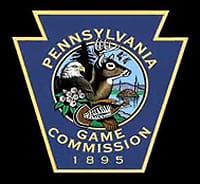Hunting and Trapping Opportunities for Winter in Pennsylvania
OutdoorHub 12.03.12

Pennsylvania Game Commission Executive Director Carl G. Roe reminds hunters and trappers they still have a mixed bag of seasons from which to choose after the statewide firearms deer season concludes on Saturday, Dec. 8. They include seasons for deer, snowshoe hare, ruffed grouse, squirrel, cottontail, pheasant, coyote, fisher, bobcat, beaver and other furbearers, crows, doves and waterfowl.
The small game seasons are: squirrel, Dec. 10-24 and Dec. 26-Feb. 23; ruffed grouse, Dec. 10-24 andDec. 26-Jan. 26; rabbit, Dec. 10-24 and Dec. 26-Feb. 23; and snowshoe hare, Dec. 26-Jan. 1 in Wildlife Management Units (WMUs) 2B, 2G and 3A. In addition, pheasants (males and females) will be open fromDec. 10-24 and Dec. 26-Feb. 2 in WMUs 1A, 1B, 2B, 2D, 2E, 2F, 2G, 3A, 3B, 3C, 3D, 4A, 4B, 4D, 5C and 5D.
The statewide late archery and flintlock muzzleloader deer seasons run concurrently from Dec. 26-Jan. 12.
For deer hunters with WMU 2B, 5C or 5D, they can choose to hunt antlerless deer with use any legal sporting arm from Dec. 26-Jan. 26, or an extended flintlock muzzleloader deer season for antlered or antlerless deer from Dec. 26-Jan. 26, or an extended archery season for antlered or antlerless deer fromJan. 14-26.
Flintlock muzzleloader season participants may harvest an antlerless deer with a WMU license, DMAP permit, or a general hunting license deer harvest tag. During the late season, antlered deer may be taken only by bowhunters and flintlock muzzleloader hunters who possess an unused general hunting license deer harvest tag.
Hunters using archery or muzzleloader licenses, and hunting with those special sporting arms, are not required to wear fluorescent orange, but are encouraged to do so, especially when hunting in WMUs 2B, 5C and 5D, where an antlerless season for limited-range firearms users will also be in progress. Refer to the Digest for firearms restrictions in special regulations areas. Hunters using conventional firearms in those WMUs must wear 250 square inches of fluorescent orange.
Furbearer hunting seasons continuing through the winter months include: red and gray foxes, until Feb. 16, including Sundays; raccoons, until Feb. 16; and bobcats, in designated WMUs, from Jan. 15-Feb. 5.
Furbearer trapping seasons include: beavers, Dec. 26-March 31 (bag limits depend on WMU, outlined on page 74 of the 2012-13 Digest); mink and muskrats, until Jan. 6; raccoons, skunks, opossums, foxes, coyotes and weasels, until Feb. 17; bobcats, in designated WMUs from Dec. 15-Jan. 6; and fishers, in designated WMUs, from Dec. 15-20.
Trappers also may use cable restraints for foxes and coyotes from Dec. 26-Feb. 17, providing they have passed a mandatory cable restraint certification course. For information on courses, visit the Game Commission’s website and click on the “Hunter Education” link in the right-hand column and choose the month of interest to find the nearest course.
Dove hunters also will have late season opportunities when dove season runs Dec. 26-Jan. 5. Hunting hours are one-half hour before sunrise to sunset, and the daily limit is 15 birds.
Waterfowl hunters have plenty of hunting opportunities to pursue from December into April. Hunters may take Canada geese and white-fronted geese during the following upcoming seasons: Atlantic Population Zone, Dec. 13-Jan. 26; Southern James Bay Canada Goose Hunting Zone, Dec. 10-Jan. 18; and Resident Canada Goose Zone, from Dec. 11-Jan. 15 and Feb. 1-28.
The regular snow goose season runs until Jan. 26 in the Atlantic Population Zone, until Jan. 18 in the Southern James Bay Zone and until Feb. 28 in the Regular Population Goose Zone. For the snow goose conservation hunt, hunters will need to obtain a free special permit in addition to other waterfowl-required federal and state licenses. Bag limits for the conservation hunt are 25 daily and no possession limit, and the season lengths for the conservation hunt are: Jan. 28-April 26 in the Atlantic Population Zone; Jan. 29-April 26 in the Southern James Bay Population Zone; and March 1-April 26 in the Resident Population Zone.
Ducks, sea ducks, coots and mergansers may be hunted in the Lake Erie Zone until Dec. 29; in the North Zone, until Jan. 5; in the Northwest Zone through Dec. 14; and in the South Zone through Jan. 15.
For details on waterfowl bag limits in each of the zones, please consult the Pennsylvania 2012-13 Guide to Migratory Game Bird Hunting, which is available on the agency’s website (www.pgc.state.pa.us) by clicking on the “2012-13 Migratory Game Bird Brochure” icon in the center of the homepage.
In addition to a regular Pennsylvania hunting license, persons 16 and older must have a Federal Migratory Bird and Conservation Stamp, commonly referred to as a “Duck Stamp” to hunt waterfowl. Regardless of age, hunters also must have a Pennsylvania Migratory Game Bird License to hunt waterfowl and other migratory birds, including doves, woodcock, coots, moorhens, rails and snipe. All migratory game bird hunters in the United States are required to complete a Harvest Information Program survey when they purchase a state migratory game bird license. The survey information is then forwarded to the USFWS.

